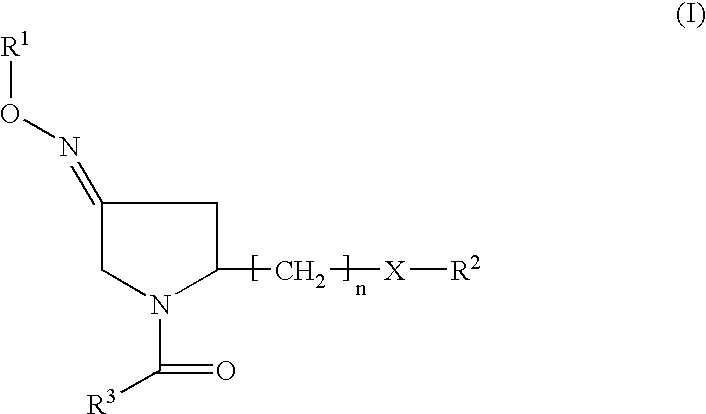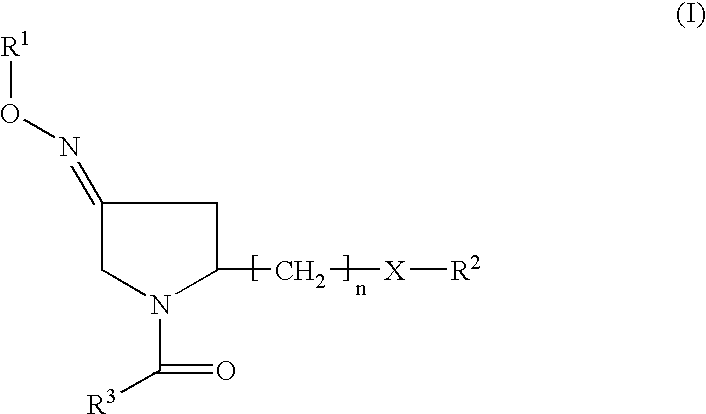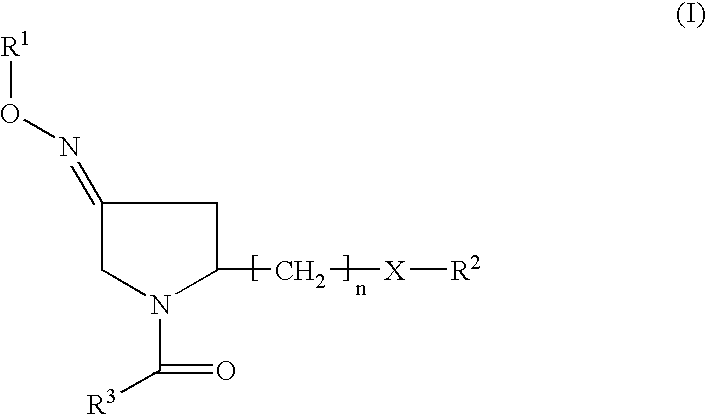Pyrrolidine derivatives as oxytocin antagonists
a technology of pyrrolidine and oxytocin, which is applied in the field of pyrrolidine derivatives, can solve the problems of unfavorable preterm labor, and unfavorable preterm labor management, and achieve the effects of reducing the risk of preterm labor
- Summary
- Abstract
- Description
- Claims
- Application Information
AI Technical Summary
Benefits of technology
Problems solved by technology
Method used
Image
Examples
examples
[0179] The invention will be illustrated by means of the following examples which are not to be construed as limiting the scope of the invention.
[0180] The compounds of the present invention may be synthesized according to the different synthesis pathways provided above. The following examples illustrate preferred methods for synthesizing the compounds according to formula I, and for determining their biological activities.
example i
(3EZ,5S)-5-(hydroxymethyl)-1-[(2′-methyl-1,1′-biphenyl-4yl) carbonyl] pyrrolidin-3-one O-methyloxime (1) (compound of formula II or formula Ia wherein R2 is H)
[0181]
Intermediate (1a): 1-(tert-butoxycarbonyl)-4-oxo-L-proline
[0182]
Ketopyrrolidine Formation:
[0183] Commercial (2S, 4R)-1-(tert-butoxycarbonyl)-4-hydroxy-2-pyrrolidinecarboxylic acid (30 g, 0.13 mol) was dissolved in acetone (1500 ml). A mechanical stirrer was placed in the flask and the solution stirred vigorously. A freshly made solution of 8N chromic acid was prepared by dissolving chromium trioxide (66.7 g, 0.667 mol) in water (40 ml), adding concentrated sulphuric acid (53.3 ml) and adding enough water to bring the solution volume to 115 ml. The 8N chromic acid solution (115 ml) was then added dropwise over a period of 30 min with continued vigorous stirring, the reaction's exotherm being maintained at the optimal temperature of 25° C. by the use of an ice bath. After the complete addition of the chromic acid, the ...
example ii
(3EZ,5S-1-(1,1′-biphenyl-4-ylcarbonyl)-5 (hydroxymethyl) pyrrolidin-3-one O-methyloxime (2), (3Z,5S)-1-(1,1′-biphenyl-4-ylcarbonyl)-5 (hydroxymethyl)pyrrolidin-3-one O-methyloxime (3), (3E,5S)-1-(1,1′-biphenyl-4-ylcarbonyl)-5-(hydroxymethyl) pyrrolidin-3-one O-methyloxime (4) (compounds of formula II or Ia wherein R2 is H)
Intermediate 2a: methyl (4R)-1-(1,1′-biphenyl-4-ylcarbonyl)-4-hydroxy-L-prolinate (compound of formula VIII)
[0198]
[0199] To a solution of 4-biphenylcarboxylic acid (17.5 g, 88.3 mmol) in DMF (100 ml) were added EDC (16.9 g, 88.3 mmol), HOBt (11.9 g, 88.3 mmol) and DIEA (27.9 ml, 183.9 mmol). The mixture was then stirred at r.t. for 10 mn before the addition of trans-hydroxy-L-proline methylester hydrochloride (10.7 g, 73.6 mmol) and left for another 48 h at r.t. under nitrogen atmosphere. It was then concentrated under high vacuum and dissolved in Ethyl acetate, washed with water, 1N chlorhydric acid solution, saturated sodium hydrogenocarbonate solution and brin...
PUM
| Property | Measurement | Unit |
|---|---|---|
| concentrations | aaaaa | aaaaa |
| volume | aaaaa | aaaaa |
| temperature | aaaaa | aaaaa |
Abstract
Description
Claims
Application Information
 Login to View More
Login to View More - R&D
- Intellectual Property
- Life Sciences
- Materials
- Tech Scout
- Unparalleled Data Quality
- Higher Quality Content
- 60% Fewer Hallucinations
Browse by: Latest US Patents, China's latest patents, Technical Efficacy Thesaurus, Application Domain, Technology Topic, Popular Technical Reports.
© 2025 PatSnap. All rights reserved.Legal|Privacy policy|Modern Slavery Act Transparency Statement|Sitemap|About US| Contact US: help@patsnap.com



